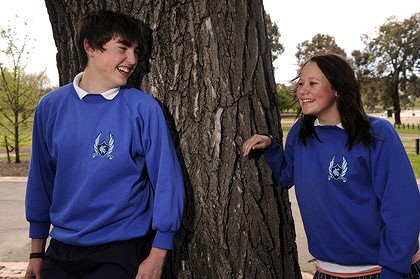This article was published in today’s Age newspaper and the results of the summit seem to be a step in the right direction regarding the problem of cyber bullying.
Stemming the tide of cyber bullying
FARRAH TOMAZIN
October 13, 2009
Korumburra Secondary College classmates William Crawford and Courtney Graue were among 240 students at the state’s first cyber bullying summit. Photo: Pat Scala
A year ago, Korumburra Secondary College student Courtney Graue became the victim of a sustained campaign of cyber bullying. What started off as schoolyard taunts and social exclusion soon transcended into the online world: derogatory messages posted on her MySpace page, claims that she didn’t have any female friends, even comments about her appearance.
”I guess girls can get jealous of different things and one girl in particular would tell me I was ugly and that I only hung out with guys because no girls would want to talk to me,” said the year 10 student.
”In the end I talked to my teachers, and even to my parents, and they sorted it out. I got over it eventually, but at the time I got fairly upset by it all, and it certainly does impact your life.”
Courtney’s story is emblematic of a much broader trend: the latest research from Edith Cowan University suggests that on any given day, about 100,000 Australian children will be bullied at school. And between 10-15 per cent are cyber bullied through social networking websites, instant online messaging, mobile phones or other forms of digital technology.
Yesterday, Courtney and classmates William Crawford and Daniel Whittingham were among 240 year 10 students who took part in the state’s first cyber bullying summit.
The conference, involving 60 public and private schools, was convened by the Brumby Government after it became so concerned by the extent of cyber bullying that it decided to seek the advice of young people on the best ways to tackle it.
While the Government has tried to crack down on the problem by updating bullying guidelines and blocking access to video-sharing websites such as YouTube and MySpace through a filter system, experts agree that past policies have not done enough.
Appearing at the conference yesterday, Premier John Brumby admitted that the ever-changing nature of digital technology had serious consequences.
”The openness and ease of online communication comes with a downside,” he said.
The summit comes only months after the death of 14-year-old Geelong schoolgirl Chanelle Rae who, according to her mother Karen, took her own life after reading something posted about her on the internet.
Edith Cowan researcher Donna Cross said it was hard to quantify how many youth suicides had been caused by cyber bullying, but there was little doubt it was a contributing factor in some cases.
The message

